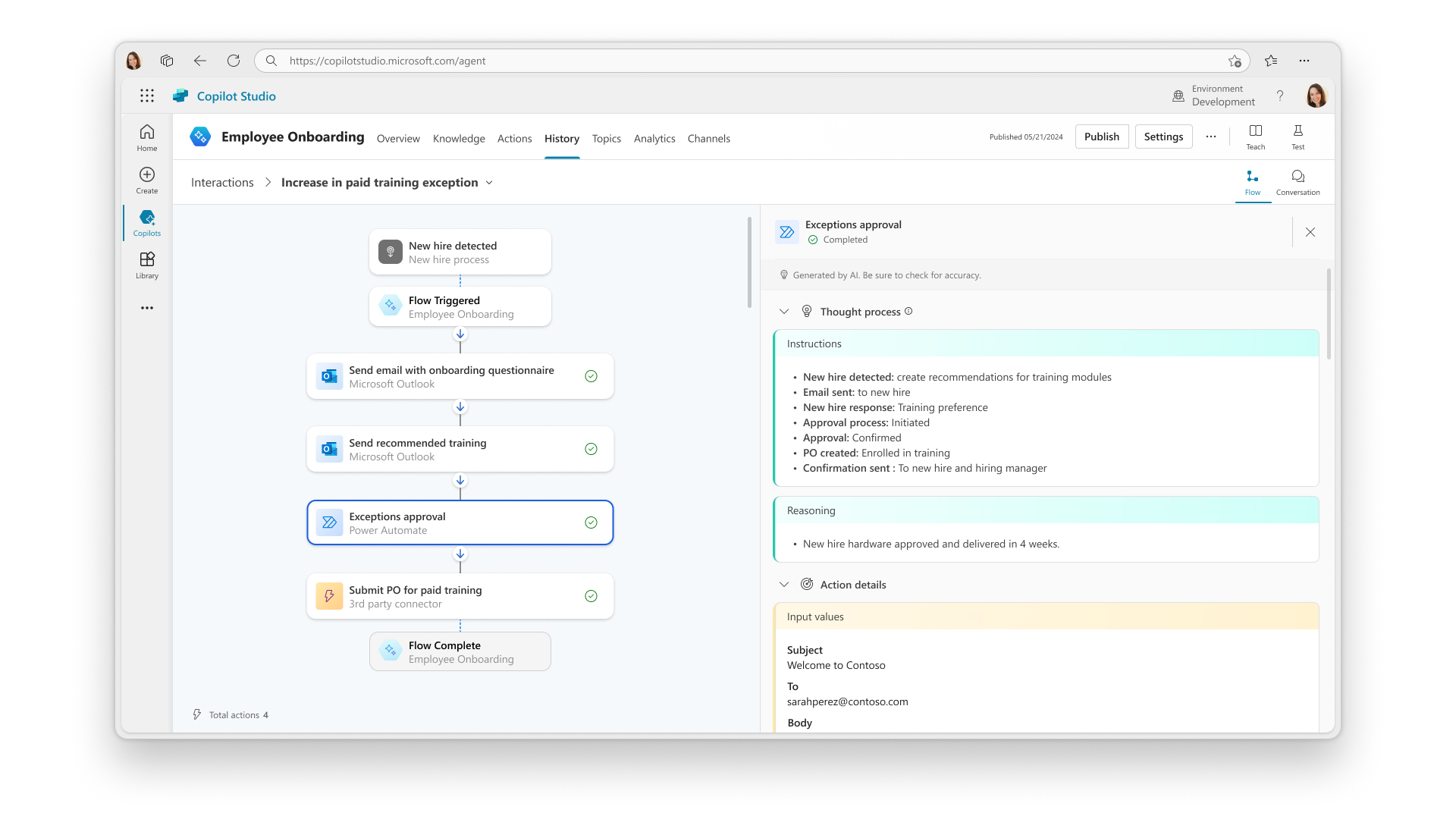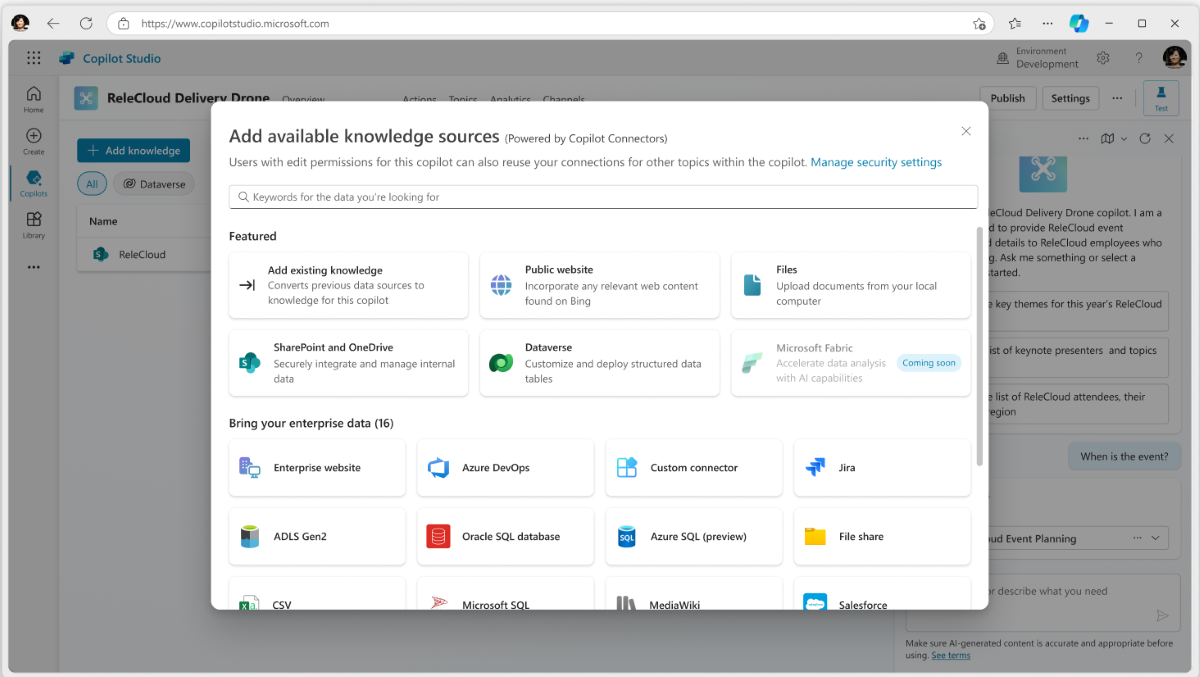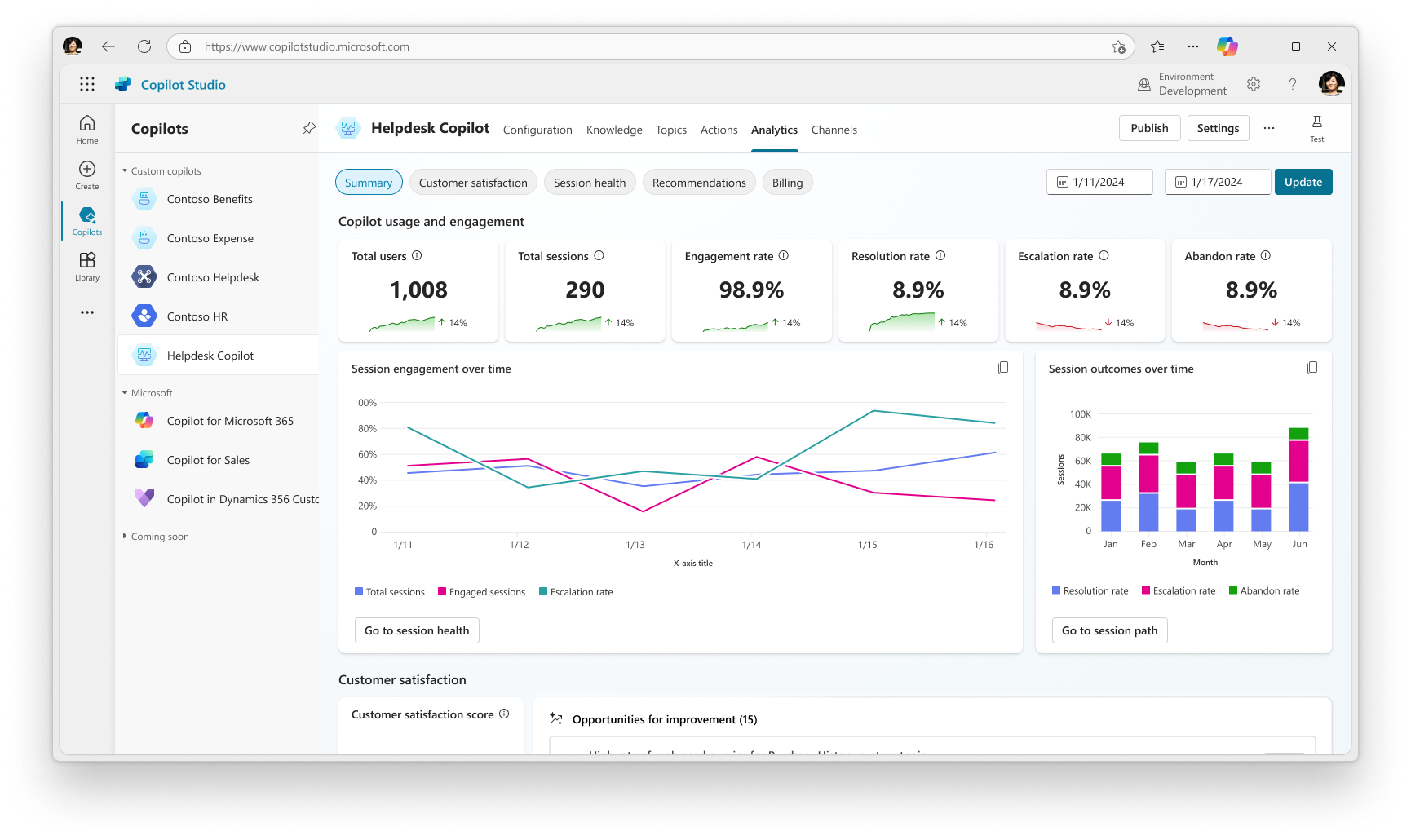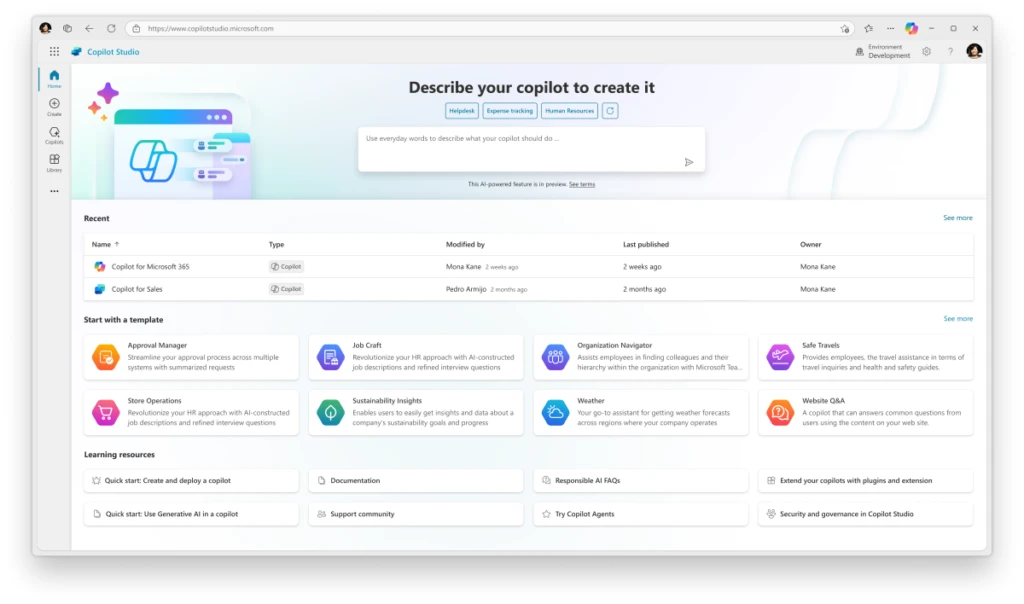At Microsoft Build 2024, we’re excited to announce a host of new powerful capabilities in Microsoft Copilot Studio—the single conversational AI tool you can use to create your very own custom copilots or extend Microsoft Copilot experiences with your own enterprise data and scenarios.
The first of these are copilots that can now act as independent agents—ones that can be triggered by events—not just conversation—and can automate and orchestrate complex, long-running business processes with more autonomy and less human intervention.
For instance, consider the potential of a copilot that can react when an email arrives, look up the sender’s details, see their previous communications, and use generative AI to trigger the appropriate chain of actions in their response. From understanding the intent of the email, to looking up the sender’s details and account, seeing their previous communications, checking inventory, responding to the sender asking for their preferences, and then taking the appropriate actions to close a ticket—orchestrating and shepherding an entire process over days.
With such capabilities, copilots are evolving from those that work with you to those that work for you. They can be designed to handle specific roles or functions, such as IT, marketing, sales, customer success, and finance across various industries, including travel, retail, and financial services.
With these new capabilities, here are some examples of the kinds of copilots our customers can build
- IT help desk. IT support is complex, involving tickets, order numbers, approvals, and stock levels. Opening and closing a ticket can be a long-running task that spans days. A copilot can now handle this process, interfacing with IT service management applications, resolving IT tickets with context and memory, creating purchase orders for device refresh, and reaching out and getting managers approvals—all independently.
- Employee onboarding. Onboarding new employees is often expensive and slow. Now, imagine you’re a new hire. A copilot greets you, reasons over HR data, and answers your questions. It introduces you to your buddy, provides training and deadlines, assists with forms, and sets up your first week of meetings. Throughout all of this, the copilot is in touch, guiding you through the weeks-long onboarding and account set up processes.
- Personal concierge for sales and service. Balancing exceptional customer experience while meeting ambitious revenue goals can be challenging. When a copilot serves guests, it can use the memory of previous conversations with guests to remember their preferences, make reservations, handle complaints, and answer questions related to the products and services on offer. The copilot learns from its interactions and proposes new ways of handling customer scenarios. By doing so, copilots can increase upsell and attachment rates, driving revenue for the resort while simultaneously enhancing guest experience, satisfaction rates, and repeat business.
Let’s dig deeper into a few of the underlying capabilities that make all this possible:
- Asynchronous orchestration of complex tasks. The first is the ability to use generative AI-powered planning and reasoning to manage complex, multistep, long-running tasks. For example, reacting to a new order means determining the need to verify inventory, triggering the right payment processes, pinging a supervisor for approval if the amount is above a certain threshold, and replying with a confirmation. Many of these events can take hours—or even days—to complete, but the copilot will run through them, maintaining the necessary state and context to do so.
- Memory and context. One of the frustrating things about support has traditionally been having to repeat information: who you are, what your policy number is, what your address is. There is no continuity of conversation. Copilots will now learn from previous conversations from the users and utilize this knowledge to continually personalize interactions. A copilot may not need to ask you for your laptop model or your address when you call again for the same issue. Conversations will thus become long-running, contextual, and deeply personalized.
- Monitor, learn, and improve. Copilots can now learn and adapt, offering monitoring and teaching capabilities to make their interactions better. Each copilot records a comprehensive history of its activities, providing transparency into its performance, including user interactions, actions taken, and feedback received, and you can see what decisions it made—and correct and teach them—with just a few clicks.

- Delegation with confidence and guardrails. When developing copilots with agent capabilities, establishing clear boundaries is paramount. Copilots operate strictly within the confines of the maker-defined instructions, knowledge, and actions. The data sources linked to the copilot adhere to stringent security measures and controls, managed through the unified admin center of Copilot Studio. This includes data loss prevention, robust authentication protocols, and more.
These advanced new capabilities in Copilot Studio are currently accessible to customers participating in an Early Access Preview where organizations such as Centro de la Familia are excited to explore agent capabilities that support teachers and case workers, allowing them to spend less time on administrative tasks and more time working with children, ultimately leading to better child outcomes. Based on feedback from program participants, we will continue to iterate and refine these capabilities for broader access in a preview planned for later this year.
Additional innovations with Copilot Studio
There’s a lot more to share at Microsoft Build with Copilot Studio, and we’ll touch on just a few of our new capabilities here. To learn more—just sign up and try it out for yourself here.
It’s easier than ever to create copilots. With Copilot Studio, creating and testing copilots is now incredibly simple. You can create your copilot with our brand new conversationally driven experience—simply describe what you want it to do, and what knowledge you want it to have, and Copilot Studio will create your very own copilot. You can then immediately test it out, add additional capabilities, such as your own actions, APIs, and enterprise knowledge—and then publish it live with a few clicks.
Connect all your enterprise data with Copilot connectors. Customers want copilots connected with data from their own enterprises business systems and apps. Copilot connectors enable anyone to ground their copilot in business and collaboration data. This makes it possible for copilots to use various data sources, including public websites, SharePoint, OneDrive, Microsoft Dataverse tables, Microsoft Fabric OneLake (coming this calendar year), Microsoft Graph, as well as leading third-party apps. You can even create your own custom generative prompts to configure how a copilot handles a response from an API or connector.
Here are a few examples of how Copilot connectors can transform copilot experiences for specific personas or functions:
- Legal and Compliance. Navigate complex legal landscapes with a Copilot extension that queries specific legal datasets, ensuring controlled and compliant responses without overwhelming users with extraneous information.
- HR Helper. Assist employees with accessing essential resources for benefits and PTO policies, and even book time off directly through Copilot.
- Incident Report Coordinator. Workers can locate the right documentation, report incidents, and track them efficiently, all within the context of the chat.
Starting in June 2024, developers can access the public preview for Copilot connectors and stay informed on updates here.
Conversational analytics (private preview): One of the most common asks from customers has been the need for deeper insight into what their copilot is doing, how generative AI is responding, when it was unable to give the right answers and why—and recommendations on what to do to improve it.
Our new conversational AI analytics and insights will help to deepen makers’ understanding of their users’ satisfaction, provide insights into the kinds of questions users are asking, which generative answers are helpful and which are not—and where adding new and updated knowledge sources or creating custom topics can help.
Templates: If simply describing your copilot to build it wasn’t easy enough, Copilot Studio will now also include a variety of pre-built copilot samples for departments and industries. Some templates—such as Safe Travels for comprehensive travel support, Organization Navigator for organizational clarity, Kudos Copilot for fostering recognition, Wellness for employee health insights—are available now, with many more releasing in the coming months.
Enhanced security and controls (public preview): Administrators can now configure advanced settings beyond the default security measures and controls. With Microsoft Purview, Copilot Studio administrators gain access to more detailed governance tools, including audit logs, inventory capabilities, and sensitivity labels. They will be able to review comprehensive audit logs that cover tenant-wide usage, inventory (with API support), and tenant hygiene (such as data loss prevention violations and inactive copilots), enabling them to effectively monitor business impact. Both creators and end-users will be able to view sensitivity labels when responses are generated using AI-powered answers based on SharePoint documents.
With all the amazing innovations, numerous organizations are using Copilot Studio to build transformative generative AI-powered solutions. Check out this story from Nsure on how they are using Copilot Studio:
Get started today with Copilot Studio
This is just a glimpse of all the exciting innovation around copilots and Copilot Studio—we have a host of exciting new capabilities to share in our sessions at Build. So, join us in watching the sessions below, and try out Copilot Studio yourself and build and share your very own copilot in minutes.
Watch the sessions at Microsoft Build:
- “Microsoft Build opening keynote”
- “Next generation AI for developers with the Microsoft Cloud”
- “Shaping next-gen development: the future of Copilot in Power Platform”
Deeper dives:
- Breakout: “What’s new with Microsoft Copilot Studio”
- Breakout with demos: “Build your own copilot with Microsoft Copilot Studio”
- Breakout with demos: “Build Microsoft Copilot extensions with Copilot Studio”
- Demo (live only): “Build your own Copilot extension with Microsoft Copilot Studio”


